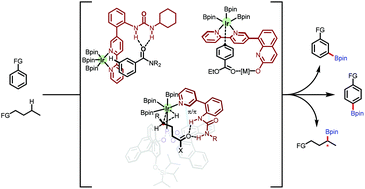Noncovalent interactions in Ir-catalyzed remote C–H borylation: a recent update
Abstract
Iridium catalyzed direct C–H borylation has provided a powerful strategy to construct a complex molecular architecture in a relatively straightforward way. Controlling regioselectivity is one of the most challenging issues in these transformations. Enormous efforts of the synthetic community have helped to overcome the selectivity issue in the case of proximal C–H borylation by introducing a directing group concept along with noncovalent interaction. However, selectively targeting a remote C–H bond is a formidable challenge and often requires special designing of the directing template. In this highlight, we aim to provide a recent update on noncovalent interaction enabled Ir-catalyzed remote C–H borylation, with a special emphasis on the corresponding enantioselective variant.


 Please wait while we load your content...
Please wait while we load your content...